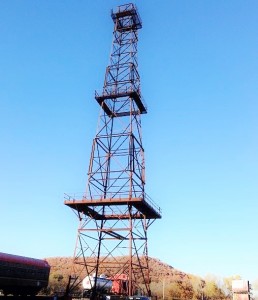Red Fork Gusher
Pennsylvania wildcatters discovered an oilfield in 1901 near Tulsa in the Creek Nation, Indian Territory.
In 1901, six years before Oklahoma statehood, discovery of the Red Fork oilfield south of Tulsa began the town’s journey to becoming “Oil Capital of the World.” Discovery of the giant Glenn Pool in 1905 helped.
Attracted to Indian Territory following an 1897 discovery at Bartlesville (see First Oklahoma Oil Well) two experienced drillers from the Pennsylvania fields found oil in the Creek Indian Nation on June 25, 1901. They drilled using steam boilers powering cable-tool derricks, the technology used to drill the first U.S. oil well in 1859 along Oil Creek in Titusville, Pennsylvania.

Dedicated during the 2007 Oklahoma centennial, a circa 1950s derrick commemorates the June 25, 1901, Red Fork oilfield discovery well. Photo courtesy Route 66 Historic Village.
After leasing thousands of acres in the Creek Nation, John S. Wick and Jesse A. Heydrick spudded their remote wildcat well near the village of Red Fork, across the Arkansas River from Tulsa. The attempt to find oil was not easy for the Pennsylvanians.
At the time, “Oklahoma Indian lands were in the process of being transferred from communal tribal ownership to individual tribal member holdings,” noted Bobby D. Weaver in a 2010 article for the Oklahoma Historical Society.
“This process, which made legal access to Indian property very uncertain, kept most oilmen away from areas under Indian control,” Weaver added. The well was almost never drilled when the St. Louis and San Francisco Railway station agent at Red Fork, “refused to accept a draft on their Pennsylvania backers to release their drilling equipment.”
Creek Land lease
The exploratory well was saved by a loan from two local doctors, John C. W. Bland and Fred S. Clinton. Drilling began at Red Fork on the tribal allotment of Sue A. Bland, a Creek citizen and wife of Dr. Bland.

Oil and natural gas exploration, production and service companies rushed to open offices in Tulsa following the 1901 oilfield discovery — and another in 1905.
Although the Sue A. Bland No. 1 well erupted an oil geyser high into the air, the discovery soon settled into production of just 10 barrels of oil a day from a depth of 537 feet. Despite the low production, the Oklahoma Territory well attracted a lot of national attention, drawing large numbers of exploration companies to the Tulsa area.
The Tulsa Democrat newspaper exclaimed, “Geyser of Oil Spouts at Red Fork” and “Oil Well Gusher Fifteen Feet High.” Within a week, Red Fork – once a quiet town of 75 people – was overrun by people clamoring for leases.

Tulsa County’s 1901 oilfield discovery was followed in 1905 by a well drilled deeper than the Red Fork production sands revealed the far bigger Glenn Pool field (above in 1909). Photo courtesy Tulsa Historical Society & Museum.
Many of the newcomers settled in Tulsa, which in 1904 constructed its first bridge across the Arkansas River to accommodate wagonloads of oilfield workers and equipment.
“The Red Fork discovery never produced a great amount of oil, with most of the wells being in the fifty-barrel-per-day range, but it did produce excitement and drilling activity,” concluded Weaver.
“The discovery also prompted Tulsa citizens to begin a strong promotional campaign, with the result that by 1904 a much needed bridge had been built across the Arkansas River,” he added. “This gave Tulsa access to the Red Fork Field and beyond and started that community on the road to becoming the predominant oil city in Oklahoma.”
The city’s petroleum industry future was assured in 1905 when a well drilled deeper than the Red Fork production sands revealed a truly massive oilfield. The Glenn Pool’s production far exceeded Tulsa County’s earlier Red Fork discovery.
Learn more in Making Tulsa the Oil Capital.
_______________________
Recommended Reading: Tulsa Oil Capital of the World, Images of America (2004); The Oklahoma Petroleum Industry
(1980); Oil in Oklahoma
(1976). Your Amazon purchase benefits the American Oil & Gas Historical Society. As an Amazon Associate, AOGHS earns a commission from qualifying purchases.
_______________________
The American Oil & Gas Historical Society (AOGHS) preserves U.S. petroleum history. Please become an AOGHS annual supporter and help maintain this energy education website and expand historical research. For more information, contact bawells@aoghs.org. Copyright © 2024 Bruce A. Wells. All rights reserved.
Citation Information: Article Title: “Red Fork Gusher.” Authors: B.A. Wells and K.L. Wells. Website Name: American Oil & Gas Historical Society. URL: https://aoghs.org/petroleum-pioneers/oklahoma-red-fork-oilfield. Last Updated: June 21, 2024. Original Published Date: June 23, 2014.


